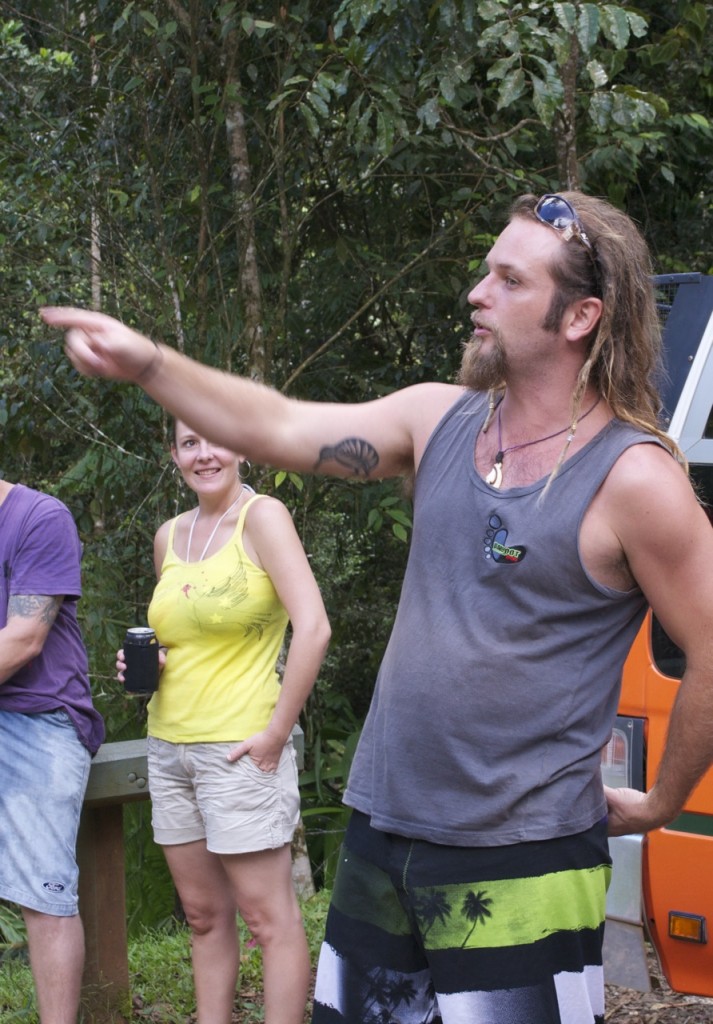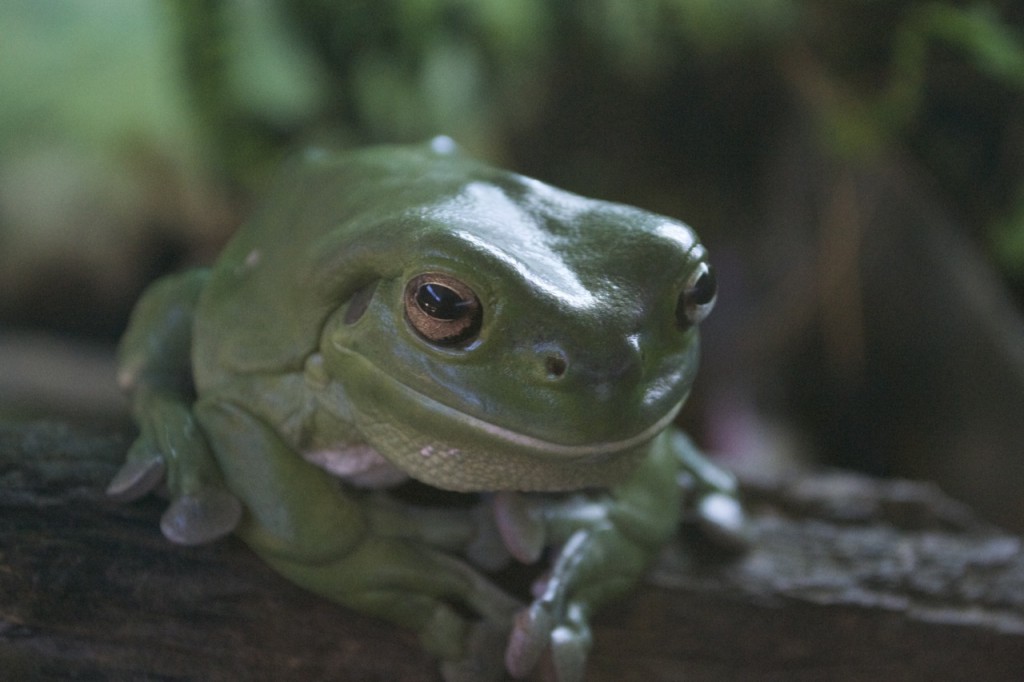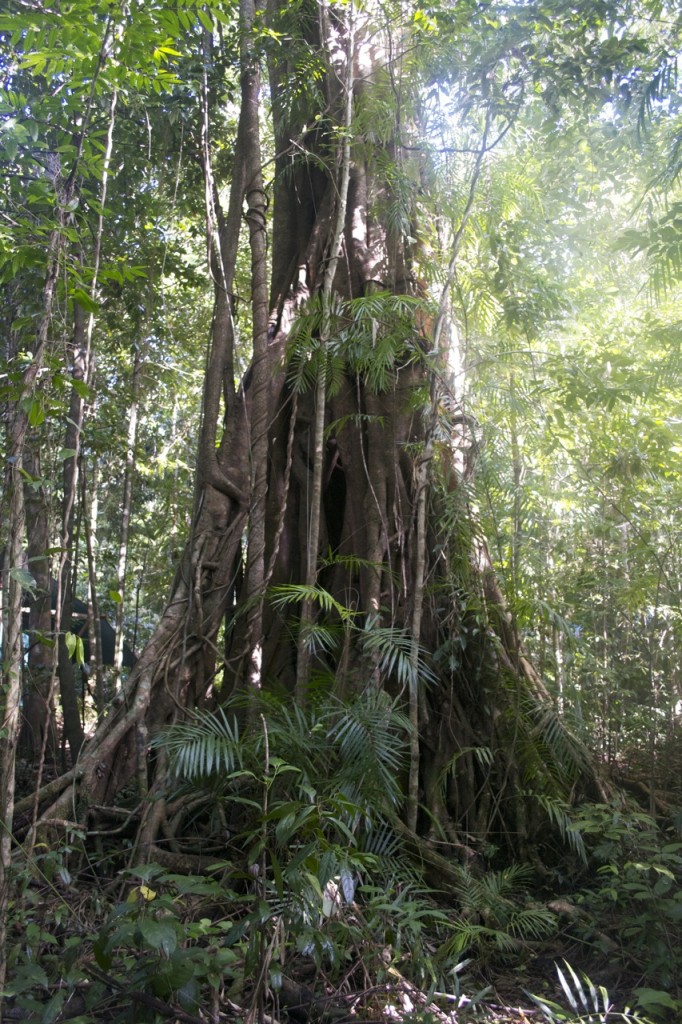
Captain Matty is a brilliant storyteller. I know because earlier this month I went on his famous tour through the rainforest of Far North Queensland, Australia. As he drove our orange bus up petrifyingly narrow, sinuous roads, Matty told tales, tall and short: about the legendary ‘drop down‘, wicked cousin of the koala, so named because it crashes down from the treetops onto its prey (including, Matty said with a wink, a Swiss-German tourist); about attending poisonous snake bites (it involves a credit card and lots of gauze); and about Aboriginal women who use a sacred waterfall to boost fertility. His most remarkable story was about the rainforest.
The Wet Tropics of Queensland span some 280 miles of coastline on the northeast side of the country, running parallel to the Great Barrier Reef. Thanks to the mash-up of Australian and Asian continental plates 15 million years ago, the area holds a supremely diverse mix of animals and plants (some of which are as much as 415 million years old). It’s difficult to describe without getting carried away, but I’ll try.
 The region’s 3,000 plant species include 13 types of rainforest, as well as woody bush, mangroves and swampland. Now fauna: 370 species of birds, 58 frogs, 41 marsupials, 36 bats. Twelve of its mammals — including green ringtail possums, a masked white-tailed rat, and two tree kangaroos — exist nowhere else in the world.
The region’s 3,000 plant species include 13 types of rainforest, as well as woody bush, mangroves and swampland. Now fauna: 370 species of birds, 58 frogs, 41 marsupials, 36 bats. Twelve of its mammals — including green ringtail possums, a masked white-tailed rat, and two tree kangaroos — exist nowhere else in the world.
Aboriginal tribes, notably the Barrineans, have lived in this rainforest for 40,000 years. The first White Guy to find it, in 1848, was British surveyor Edmund Kennedy, who died later that year at the end of an Aboriginal spear. White settlers wasted no time in clearing red cedar trees for lots of money. (According to Captain Matty, the 180-foot red cedar is literally worth its weight in gold.) For the next century, commercial development continued and the rainforest ecosystem gradually receded.
 Happily, the destruction train derailed in 1988, when the Wet Tropics officially became a World Heritage site, meaning that it is legally protected from development. Since then, Captain Matty said, the number of rainforest critters, including endangered ones, has blossomed.
Happily, the destruction train derailed in 1988, when the Wet Tropics officially became a World Heritage site, meaning that it is legally protected from development. Since then, Captain Matty said, the number of rainforest critters, including endangered ones, has blossomed.
Unfortunately, their lush habitat hasn’t grown at the same pace.
So the forest’s caretakers came up with a solution: habitat corridors. These are narrow strips of newly planted trees and vegetation that connect one patch of healthy rainforest to another. Within just a couple of years, Matty said, wildlife can and do use the corridors for migration.
But that leads to another problem. Sometimes, the corridors are built on land bought from local farmers. The farmers get a good price for it, Matty said, but the corridor sometimes transects their farms, preventing them from, you know, farming. This leads to another work-around. Apparently it’s fairly common agricultural practice to build underground tunnels that connect one side of a farm to the other.
At first, this whole scheme sounded a bit crazy to me. But Matty grew up on a dairy farm in New Zealand. So for this tale, anyway, I’ll believe him.
**
Photos (click on them for glorious full size!) taken by yours truly.
Before this trip, I didn’t know much about rainforest, let alone the Wet Tropics of Queensland. I gleaned most of the information in this post from fact sheets and websites of the World Heritage Convention and the Wet Tropics (and, of course, from the Captain).
I couldn’t find much about why and how, exactly, farmers outside of the rainforest use those underground tunnels. If readers know anything about this, I’d love to hear it.
Do continental collisions usually lead to diversity is species? I’d never heard that, it makes perfect sense — assuming the species are older than the collisions — and so why haven’t I heard that? I’m just not listening in the right places?
Above my pay grade, Ann, I’m just a brain science writer. Maybe Tom knows…?
Thank you for providing me with the idea of an imaginary bear dropping out of the trees onto unfortunate victims.
Ann, I think species diversity after a continental collision is initially strictly additive: species complement A + species complement B = new combined species complement. That’s until they start eating one another of course, or otherwise out-competing one way and another, and if I’m not mistaken, diversity is most likely to drop back down to an equilibrium level after most collisions. Smarter people can correct me if I’m wrong, but I think this is one of those areas where relatively high, wet mountains, separated by hotter lowlands, are important…they should act like little evolutionary islands, with lots of niche diversity up and down the elevation where founding species from A or B can survive and diversify in relative isolation from one another, even though the linear distance between them isn’t great. People smarter still can tell me whether I’m right that 15 million years ago is recent enough that all these dynamics are still playing out, i.e a new equilibrium may not have been reached before we all showed up and started changing the equation yet again.
C’mon, Tom. Nobody’s smarter than you. And thank you — that’s very interesting and I hadn’t known a lick of it.
Ah! The fabled “drop bears”…Rosie, your ratbag brother would probably have used them against kid sister! 😉
And I think Tom is probably on the money. Certainly climate is a factor.
Connecting tunnels – yes, farmers (at least in NZ) do use them. Once, they drove the cows/sheep across a road to be milked, but when the roads became major highways, tunnels were worth the expense when reckoned against stock losses and possible lawsuits.
Most, I think, would accommodate a quadcycle.
So in the rainforest it would allow farming access without compaction damage to forest.